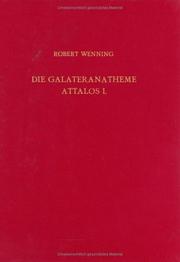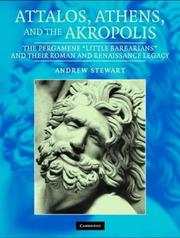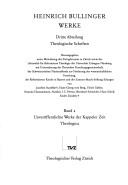| Listing 1 - 9 of 9 |
Sort by
|
Book
Year: 1978 Publisher: Paris : Arthème Fayard,
Abstract | Keywords | Export | Availability | Bookmark
 Loading...
Loading...Choose an application
- Reference Manager
- EndNote
- RefWorks (Direct export to RefWorks)
Book
ISBN: 9782708410220 2708410229 Year: 2017 Publisher: Paris : Picard,
Abstract | Keywords | Export | Availability | Bookmark
 Loading...
Loading...Choose an application
- Reference Manager
- EndNote
- RefWorks (Direct export to RefWorks)
"À partir d'une analyse systématique des textes gréco-latins, Luc Baray explore les principales facettes du mode de fonctionnement du mercenariat celtique : origines ethniques et géographiques, modalités de recrutement ou de rémunération, effectifs des contingents mobilisés, commandement, discipline, armement. II s'intéresse aux procédures et techniques mises en place pour recruter, encadrer et gérer ces troupes. Les mercenaires celtes étaient-ils moins bien payés que leurs homologues étrangers ? Etaient-ils placés sous le commandement d'officiers grecs ou puniques ou avaient-ils leurs propres officiers ? Devaient-ils se présenter armés au moment du recrutement ? Qui les équipait ? Il étudie aussi les rapports qui ont pu exister entre les employés et leurs employeurs. Quelle part ont-ils pris dans le déclenchement de la 'guerre des Mercenaires' ? Ont-ils été particulièrement déloyaux envers leurs employeurs, comme le laisse entendre une tendance lourde de l'historiographie ancienne et moderne ? Une attention particulière est portée à l'image du guerrier celte et plus spécialement à celle du mercenaire comme menace pour la citoyenneté. Démontrant l'inanité des stéréotypes véhiculés par les auteurs antiques et repris par les modernes, l'auteur propose une mise en perspective renouvelée d'un phénomène militaire de grande ampleur qui marqua de son empreinte l'ensemble des civilisations du pourtour méditerranéen des cinq derniers siècles avant J.-C. II établit pour la première fois une synthèse précise et complète de nos connaissances sur un sujet jusqu'alors pas ou peu abordé."--Page 4 of cover.
Mercenary troops --- Celts --- Galatians --- Gauls --- Mercenaires --- Celtes --- Galates --- Gaulois --- History --- Histoire --- Europe --- Mercenaires celtes --- Celtic antiquities. --- Mercenary troops. --- To 1500 --- Mediterranean Region --- Mediterranean Region. --- History, Military. --- Celtes. --- Galates. --- Gaulois. --- Celtic antiquities --- History.
Book
Year: 1971 Publisher: Würzburg : K. Triltsch,
Abstract | Keywords | Export | Availability | Bookmark
 Loading...
Loading...Choose an application
- Reference Manager
- EndNote
- RefWorks (Direct export to RefWorks)
Sculpture, Greek --- Sculpture, Pergamene --- Galatians in art --- Sculpture grecque --- Sculpture pergamienne --- Galates dans l'art --- Epigonus --- Attalus --- Monuments
Book
ISBN: 9789042946088 9042946083 Year: 2022 Publisher: Leuven Paris Bristol, CT Peeters
Abstract | Keywords | Export | Availability | Bookmark
 Loading...
Loading...Choose an application
- Reference Manager
- EndNote
- RefWorks (Direct export to RefWorks)
Stephen Mitchell's Anatolia (1993) and Karl Strobel's Die Galater (1996) were by no means end points for the study of Hellenistic and Roman Galatia. Rather, they stimulated several new research initiatives. The introduction to this volume synthesises the results of some 700 mostly very recent scholarly publications, before ten case studies explore new trends in military, political, cultural and religious history. Methodologically refined approaches to the fragmentary literary sources have nuanced our understanding of the Galatians' migration, settlement, state formation, warfare and diplomacy. Investigations into the Galatians as the object of Attalid and Seleukid propaganda are complemented by studies into their political agency as independent tribes with varying objectives. For the Roman period, Greek inscriptions available in constantly growing numbers, besides coinage and other archaeological data, allow for a nuanced understanding of what provincialisation meant in practice: the loss of political autonomy was immediate (25 BC), as was the foundation of colonies in Pisidia; a landscape of monumentalised cities in the heartland of Galatia followed only slowly in the course of the next century. Cultic innovation was also diverse: the temple for the goddess Roma and the god Augustus was constructed in Ankyra from 5 BC to AD 14, whereas traditional Hellenistic-Phrygian cults densely resurface in the epigraphic evidence of the 2nd and 3rd centuries AD. Interest in Paul's evangelisation of Asia Minor has been the catalyst of scholarly interest in the Galatians since the 4th century. Two studies devoted to the historical context of Paul's Letter to the Galatians try to connect the bulk of Pauline scholarship with latest research on urbanisation, ethnic constructs and spatial conceptions in the Graeco-Roman world, to lift discussions to a new level.
Galatians --- History. --- Galatians. --- Historical geography. --- Civilization. --- Celts --- Turkey --- Turkey. --- Galatia (Turkey) --- Galatia. --- History --- Historical geography --- Civilization --- Antiquities. --- Galates --- Victoire --- Histoire. --- Antiquité.
Book
ISBN: 9788891800312 8891800317 Year: 2014 Publisher: Milano : Electa,
Abstract | Keywords | Export | Availability | Bookmark
 Loading...
Loading...Choose an application
- Reference Manager
- EndNote
- RefWorks (Direct export to RefWorks)
Marble sculpture, Classical --- Sculpture, Pergamene --- Marble sculpture, Roman --- Death in art --- Galatians in art --- Sculpture en marbre antique --- Sculpture pergamienne --- Sculpture en marbre romaine --- Mort dans l'art --- Galates dans l'art --- Copie --- Exhibitions. --- Copying --- Expositions
Book
Abstract | Keywords | Export | Availability | Bookmark
 Loading...
Loading...Choose an application
- Reference Manager
- EndNote
- RefWorks (Direct export to RefWorks)

ISBN: 3110070537 9783110070538 Year: 1978 Volume: 4 Publisher: Berlin: de Gruyter,
Abstract | Keywords | Export | Availability | Bookmark
 Loading...
Loading...Choose an application
- Reference Manager
- EndNote
- RefWorks (Direct export to RefWorks)
Galatians in art --- Sculpture, Pergamene --- Galates dans l'art --- Sculpture pergamienne --- Attalus --- Monuments --- Bergama (Turkey) --- Pergamum (Extinct city) --- Bergama (Turquie) --- Antiquities --- Antiquités --- Turkey --- -Turkey --- Antiquities. --- Galatians in art. --- Sculpture, Pergamene. --- Antiquités --- Pergamon (Turkey) --- Pergamo (Turkey) --- Pergamum (Turkey) --- Bergamum (Turkey) --- Pergamos (Turkey) --- Pergame (Turkey) --- Pergames (Turkey) --- Bergama (Turkey) - Antiquities --- Turkey - Antiquities

ISBN: 0521831636 Year: 2004 Publisher: Cambridge : Cambridge university press,
Abstract | Keywords | Export | Availability | Bookmark
 Loading...
Loading...Choose an application
- Reference Manager
- EndNote
- RefWorks (Direct export to RefWorks)
Beeldhouwkunst in marmer [Romeinse ] --- Galatians in art --- Marble sculpture [Roman ] --- Roman marble sculpture --- Sculpture en marbre romaine --- Victory in art --- Marble sculpture, Roman --- Sculpture, Pergamene --- Galatians in art. --- Sculpture pergamienne --- Galates dans l'art --- Victoire dans l'art --- Expertising --- Copie --- Expertise --- Copying --- Bergama (Turkey) --- Acropolis (Athens, Greece) --- Bergama (Turquie) --- Acropole (Athènes, Grèce) --- Antiquities. --- Antiquités --- Victory in art. --- Expertising. --- Reproduction. --- Acropole (Athènes, Grèce) --- Antiquités --- Reproduction --- Pergamon (Turkey) --- Pergamo (Turkey) --- Pergamum (Turkey) --- Bergamum (Turkey) --- Pergamos (Turkey) --- Pergame (Turkey) --- Pergames (Turkey) --- Akropolis (Athens, Greece) --- Athenian Acropolis (Athens, Greece) --- Antiquities --- Sculpture pergaménienne --- Sculpture --- Athènes (Grèce) --- Sculpture antique --- Influence --- Rome --- Offrande attalide --- Thèmes, motifs


ISBN: 3290100006 3290114686 9783290174101 9783290175269 9783290174606 9783290176655 9783290177348 9783290177843 329017784X 9783290181987 3290181987 9783290182755 9783290100001 9783290114688 3290176657 329017526X 3290177343 3290174107 3290174603 3290182940 3290180263 3290180050 Year: 1983 Volume: 1-9 Publisher: Zürich: Theologischer Verlag,
Abstract | Keywords | Export | Availability | Bookmark
 Loading...
Loading...Choose an application
- Reference Manager
- EndNote
- RefWorks (Direct export to RefWorks)
Églises réformées --- Sermons latins médiévaux et modernes --- Sermons --- 2 BULLINGER, HEINRICH --- Godsdienst. Theologie--BULLINGER, HEINRICH --- 2 BULLINGER, HEINRICH Godsdienst. Theologie--BULLINGER, HEINRICH --- Bible. N.T.. Épîtres. Paul. Romains --- Bible. N.T.. Épîtres. Paul. Corinthiens --- Doctrines --- Bible --- Commentaires --- Bible. N.T.. Épîtres. Paul. Thessaloniciens --- Bible. N.T.. Épîtres. Paul. Timothée --- Bible. N.T.. Épîtres. Paul. Tite --- Bible. N.T.. Épîtres. Paul. Philémon --- Bible. N.T.. Épîtres. Paul. Galates --- Bible. N.T.. Épîtres. Paul. Éphésiens --- Bible. N.T.. Épîtres. Paul. Philippiens --- Bible. N.T.. Épîtres. Paul. Colossiens --- 22.01*01 --- 22.01*01 Inleidende richtlijnen voor het lezen van de bijbel. Doctrinele standpunten --- Inleidende richtlijnen voor het lezen van de bijbel. Doctrinele standpunten --- Bible. --- Philemon (Book of the New Testament) --- Titus (Book of the New Testament) --- Timothy (Books of the New Testament) --- Desalloniga (Book of the New Testament) --- Thessalonians (Book of the New Testament) --- 227.1*1 --- 227.1*2 --- 227.1*2 Brieven van Paulus aan de Corinthiërs --- Brieven van Paulus aan de Corinthiërs --- 227.1*1 Brief van Paulus aan de Romeinen --- Brief van Paulus aan de Romeinen --- 253 --- Zielzorg. Pastoraat --- Théologie pastorale --- Doctrines. --- Théologie pastorale.
| Listing 1 - 9 of 9 |
Sort by
|

 Search
Search Feedback
Feedback About UniCat
About UniCat  Help
Help News
News